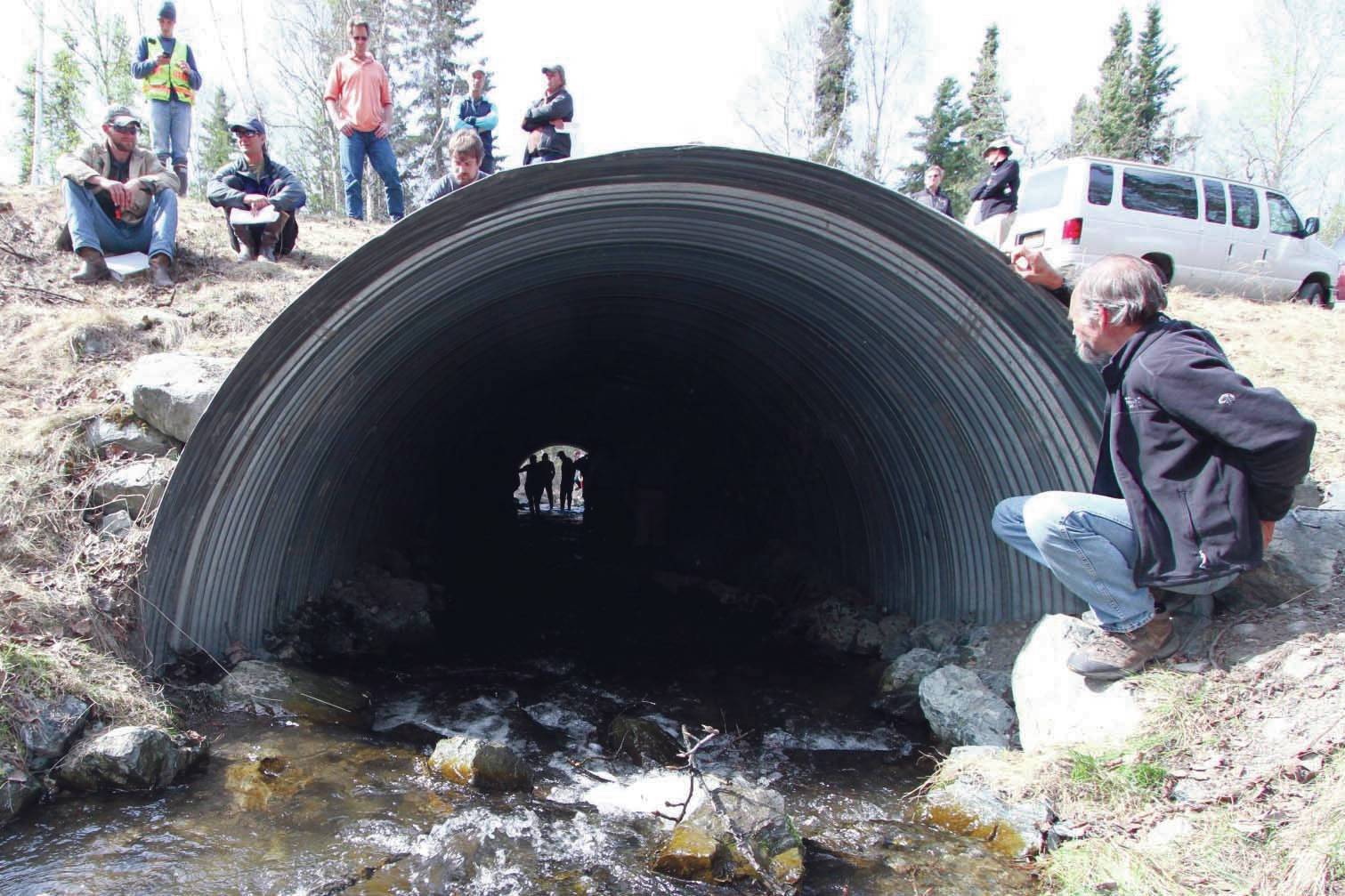Have you ever considered how many salmon streams you cross on your daily drive to work, school or another location you frequent? My number is five.
Most of the salmon streams on my route are small and nameless. Most people are surprised salmon are found in those streams.
Unless you live very close to your workplace you probably cross a salmon stream or two on your daily route. In fact, it would be difficult to travel more than a couple of miles in our region without intersecting a stream important to salmon and other aquatic organisms.
With the ease and speed at which we travel today it is easy to forget what is actually occurring under the road at stream crossings. The streams I cross are contained by culverts that function as hydraulic conduits, conveying water from one side of the road to the other. Simple, right? Well, not quite.
Culverts that are undersized are a big problem for fish. When fish cannot get to where they need to go it often results in fewer fish, especially for migratory fish such as salmon.
The survival of fish depends on free movement to find food and good places to spawn or find cover from predators. Fewer fish threaten our recreational pursuits, traditions and ultimately hit us in the pocketbook.
Undersized culverts can actually function like a giant fire hose during times of high water flow, projecting fast flowing water and making it difficult for salmon to move upstream.
Alternatively, culverts installed directly on the stream bottom, rather than being sunk into the streambed, often become “perched” when the culvert’s downstream end hangs above the level of the stream elevation. These mini waterfalls create barriers for fish that do not have extreme leaping abilities.
Both scenarios are bad for fish and Alaskans who depend on fish economically, recreationally or as a traditional food source.
Fortunately, in the past decade, culverts that pass salmon have become a topic of much interest to civil engineers, construction companies and community groups, in addition to government agencies such as the U.S. Fish and Wildlife Service.
In fact, the USFWS has a National Fish Passage Program that is managed out of the Kenai Fish Wildlife and Conservation Office. The USFWS works closely with municipalities, tribes, nongovernmental organizations and a host of other stakeholders to solve current and prevent future fish passage concerns.
The USFWS has staff with technical training that can support landowners or managers by developing a fish friendly design and providing partial replacement funding. Because of a partnership approach there are a growing number of success stories throughout the Kenai Peninsula. Troublesome culverts are being replaced with fish friendly culverts. New culverts are being designed with fish in mind.
Amidst all the road construction throughout the Kenai Peninsula over the past two summers, a number of undersized culverts were replaced with fish friendly culverts.
Of note, the Crooked Creek crossing on the Sterling Highway was replaced with a much larger culvert that adequately passes a 100-year flood while allowing juvenile salmon to move upstream unhindered. A large part of the funding for this project came from the Exxon Valdez Oil Spill investment fund, a fund created by the Exxon Valdez Trustee Council to hold settlement funds paid by Exxon after the Exxon Valdez oil spill.
In the past five years, the Trustee Council has committed tens of millions of dollars to improve road crossings within the region affected by the 1988 Exxon Valdez oil spill. With budgets stretched tight, the EVOS funds have enabled the Alaska Department of Transportation to correct undersized culverts as part of the already scheduled highway upgrade projects.
Considering the lofty price tag for replacing a stream crossing with a larger culvert or bridge, replacement of certain culverts would be unreachable without the EVOS funds. In addition to replacing the poorly performing Crooked Creek culvert, the Trustee Council contributed to the replacement of both the Coal Creek and Slikok Creek culverts on the Sterling Highway in 2019.
Still ahead, the Trustee Council has obligated funding for replacing the Two Moose Creek and Anchor River crossings on the Sterling Highway as well as another culvert on the North Fork of the Anchor River near Nikolaevsk.
Looking forward even further, Alaska Department of Transportation is planning a large Seward Highway rehabilitation project that includes the entire Moose Creek watershed near the Trail Lake Fish Hatchery. Because of a number of 1950s-era failing and undersized culverts on Moose Creek, adult and juvenile salmon have only had access to a portion of the watershed for decades.
A partnership of state and federal agencies petitioned the EVOS Trustee Council this past fall to contribute funding toward three undersized fish barrier culverts that will not be addressed as part of the Alaska Department of Transportation highway rehabilitation project. Unfortunately, the EVOS Trustee Council did not choose to fund this important project so the consortium will broaden the partnership and look for funding sources elsewhere.
Constructing fish friendly road crossings throughout the Kenai Peninsula is a win-win for both people and fish. For that reason, the USFWS will continue to support fish friendly crossings, ranging from large scale projects on highways to working with private landowners on access roads that cross small tributary streams.
The next time you are out and about, consider: How many times do you cross streams important to salmon? If the crossings were designed and constructed with fish in mind, you can be sure that fish are moving freely. If you are concerned that a particular stream crossing restricts fish moving upstream please contact the USFWS at 907-260-0130.
Kyle Graham serves as a Fish and Wildlife Biologist at the Kenai Fish Wildlife Conservation Office. He can be reached at kyle_graham@fws.gov or (907) 260-0130. If you would like learn more about the location of anadromous stream crossings in your area, see the Alaska Department of Fish and Game’s Anadromous Waters Catalog at https://www.adfg.alaska.gov/sf/SARR/AWC/index.cfm?ADFG=main.interactive.
By KYLE GRAHAM
Refuge Notebook


